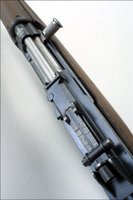In the 1930's, the day of the bolt-action military service rifle was about to draw to a close. In the Soviet Union, designers were turning out limited-issue weapons like the SVT, while in the US, the American Army was about to adopt the first general-issue military self-loading rifle, the "Rifle, .30 Caliber, M1" (now more widely known by its designers' name: Garand.)
Meanwhile, in little Belgium, Dieudonne Saive and the engineers at Fabrique Nationale were hard at work on their own self-loading design, but were still in the prototype phase when WWII halted work. Skipping town ahead of the advancing Jerries, the FN crew attempted to interest the British in their new weapon, but the Brits preferred to stick with the Enfield rather than change horses in midstream.
After the war, development work resumed, resulting in the weapon being adopted by the Belgian Army as the SAFN-49. It's a well-made rifle, with an intricately-machined steel receiver, a tipping bolt operated by a gas piston over the barrel, and a ten-round magazine that does not detach for reloading, but is topped off through the top of the receiver with stripper clips. Belgian rifles were in .30-'06 to take advantage of NATO largesse, but export rifles were done in other calibers as well, including 8x57mm and 7x57mm.
The sights consist of a receiver-mounted aperture on tangent adustable for elevation, and a front blade adjustable for windage, protected by beefy wings. The safety is a simple pivoting lever next to the trigger. The gun was remarkably successful on the export market, especially in light of the fact that it was not very simple to manufacture, and the additional fact that the US and USSR were giving rifles away pretty much for the asking. It saw service in the Middle East, Southeast Asia, and all over South America. Mine was made at FN Herstal for the Egyptians. It's chambered in 8mm Mauser, and has its sight labeled in Arabic numbers.
In the end, what put paid to the rifle was the move of the world's armies to select-fire weapons using intermediate-length cartridges. While the SAFN itself didn't survive this change, its genes did, as anyone who looks at one of these side-by-side with a certain more famous FN rifle can see.
As a footnote, this is probably the most modern military surplus rifle a US collector can own without NFA paperwork. Most subsequent designs were select-fire, and while parts-kit guns like FALs, CETMEs, and G3s can be fun to own, there's always something different about holding a true milsurp; a gun that was once actually a service arm, and is now honorably retired without having suffered the indignity of being chopped up with a cutting torch.
Subscribe to:
Post Comments (Atom)



4 comments:
How's the black paint holding up on your ABL?
Er, "ABL"?
That's what the Belgians call it, Armee Belge Leger (ABL). French? Flemish? I dunno. ;)
Actually, judging by the wear on various bearing surfaces, mine appears to be finished with a traditional blueing process of some kind.
Post a Comment